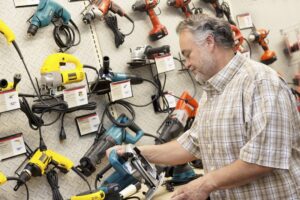
Drills and sanders and saws, oh my! Many first-time DIYers choose a power drill as their first power tool.
Are you thinking about getting a loved one a power drill for Christmas? Or perhaps you are getting into DIY projects and need to equip yourself with the right tools. If you’re wondering how to make the right purchase, this guide will give you everything you need for choosing a power drill.
Choosing a Corded Power Drill
Are you planning on drilling holes in metal, plastic, wood, brick, stone, concrete, glass, or tile? Then a corded power drill may be for you. These drills generally come in a speed between 500 to 800 watts. If you can find a drill with around 650 to 700 watts, then it will be strong enough for most jobs. Some corded power drills have a fixed speed setting, two speed settings, or a variable speed setting. The variable speed is the best choice, especially for beginners, because it allows you to slowly and gradually increase the speed so that the drill bit doesn’t wobble everywhere when you start drilling.
When you use a cordless power drill, first you’ll insert the drill bit. This is the part of the drill that does the actual drilling. A drill bit can also be shaped like the tip of a screwdriver for drilling in screws. The drill bit is held in a clamping device on the end of the drill called a chuck. Some chucks are keyless and require hand tightening, while others need to be tightened with a chuck key. Be sure to talk to your friendly neighborhood hardware store salespeople. We’re happy to help you in the process of choosing a power drill!
Protip: Will you be drilling at a lower speed? It’s a good idea to purchase larger diameter drill bits in order to avoid overheating from friction.
Choosing a Cordless Power Drill
Don’t like the idea of dragging a cord around? Or are you planning on drilling in a hard-to-reach space? Then the cordless power drill will be best for you. A cordless drill can go with you as you climb ladders, crawl into small spaces, work on the roof, and do other awkward or precarious projects. If you’re planning on drilling into masonry, a combi action drill that combines a hammer function with drilling makes the job easier. When buying a cordless power drill, you’ll notice that they are available in battery voltages of 10.8 to 36 volts. A higher voltage is better for drilling bigger diameter holes, but if you aren’t sure what voltage to look for, 14.4 or 18 volts are good choices for general projects.
Protip: Since cordless drills don’t have a constant power source, you’re completely reliant on batteries. Buy a cordless drill with an extra battery so that one can charge while the other is in use.
Get Quality Supplies from Fisher Lumber
Fisher Lumber and Hardware has served homeowners and contractors in the Maryland, Washington, D.C., and Northern Virginia areas since 1894. We have excellent lumber, all of the building materials you need, top-notch tools, and the expertise to help you pick the right supplies for your project. Give us a call at 301-424-6500 or visit us online for more information. To see more tips for your DIY project, visit us on Facebook, Pinterest, Google+, Houzz, and Twitter!
